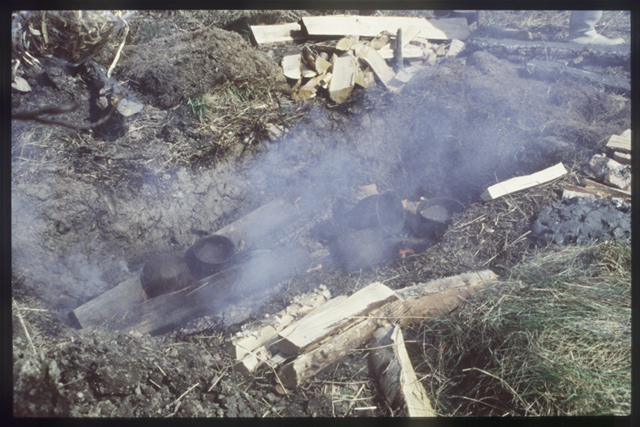 FIRING OF VIKING AGE CERAMICS
FIRING OF VIKING AGE CERAMICSIntroduction | Research | People | Tools
 FIRING OF VIKING AGE CERAMICS
FIRING OF VIKING AGE CERAMICS
Ceramics are ready.
Artefact type: Reconstructed clay vessels in an experimental firing.
Use: The firing of pottery in a covered kiln structure.
Location: Krookila.
Period: Modern.
Dating: 1997 A.D.
Photographer: Jari Näränen
The essential thing about the covered kiln structure is that the flow of oxygen has been reduced to the minimum. As a result of that the iron oxide, which is naturally present in the clay body, will not oxidate and turn red but remains grey.
The volatile carbon particles present in the burning process will attach and fix into the small pores in the surface. The fixation is aided by the animal fat smeared onto the surface. The black colour obtained in this manner is wash proof. The polishing of the surface (done during the drying process) will enhance the effect and lustre of the colour.
However, the polishing of the surface is a risk factor during the firing: A hard and dense surface structure is a good conductor of heat, which is why the sudden changes in temperature and the thermal behaviour (shrinkage, expansion) will have severe effects on the clay body. A more porous interior structure will not follow the thermal behaviour of the surface and tensions will build up on the border zone.
The changes in temperature are greatest in the open fire, where the different burning gases can influence the firing in an unpredictable way. Thus the open air firing is safest on the porous vessels with an even structure, where the pores in fact prevent the conducting of the heat. When the effect of the heat is slightly inhibited, the sudden changes in temperature will not result in harmful effects but will be buffered instead.
In a covered kiln the rise and fall of temperature - and the risks resulting from that - are somewhat regulated. In that atmosphere even the polished vessel has a fair chance to survive.
< Previous 10/10
Introduction | Research | People | Tools